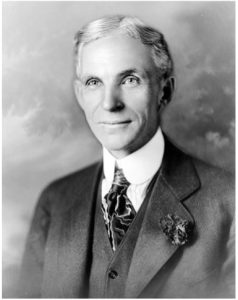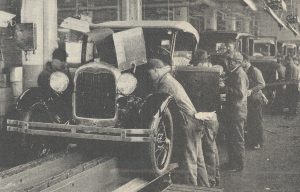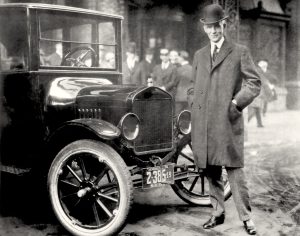3 Henry Ford
Moving assembly line, Relentless pursuit of cost reduction through shortening lead times, Respect for employees
Resa Wise; Rick Hardcopf; and Mike Dixon
Henry Ford (1863 – 1947)
Moving assembly line, Relentless pursuit of cost reduction through shortening lead times, Respect for employees
Henry Ford was born July 30, 1863, in Springwell’s Township, Michigan. He showed an interest in mechanics as a young age. By age 12, he spent significant time in a machine shop; by 15, built a small steam engine, by 30, built a small gasoline engine, and by age 33, built his first car. During his early career, Ford was the chief engineer at the Edison Illumination Company of Detroit. Thomas Edison was a lifelong friend and mentor of Ford. Ford’s business ventures included starting several companies, the third of which was Ford Motor Company. Ford Motor Company sold its first car on July 15, 1903.

Ford’s Vision
In the early 1900s, Henry Ford set out to make a car like no other on the market at that time, something he called the “everyman’s car”. His goal was a powerful, durable, yet lightweight automobile that could handle the muddy, rutted roads that were commonplace at the time. This idea materialized as Ford’s famous Model T. The Model T carried five passengers, instead of just two like its Model N predecessor. Ford carefully oversaw every aspect of the Model T’s creation. Beyond being rugged, it was affordable and opened automobile transportation of for the middle class. The Model T listed a 5 passenger, 4-cylinder, 20 horsepower touring car for $850 in 1909, but because of improvements in the production process the price of the Model T decreased year after year to only $260 by 1924. Demand for the Model T was instant, with 15,000 orders in the first few days after its release. Ford Motor Company made the Model T for 18 years and by 1927 had sold more that 15 million of them.
“I will build a car for the great multitude. It will be large enough for the family, but small enough for the individual to run and care for. It will be constructed of the best materials, by the best men to be hired, after the simplest designs that modern engineering can devise. But it will be low in price that no man making a good salary will be unable to own one-and enjoy with his family the blessing of hours of pleasure in God’s great open spaces.”
Introducing the Assembly Line
The standardized design of the Model T included only one frame or chassis for all sub-models allowing specialized tools on the production line. By 1913, paint was also standardized leading to Ford’s famous line “You could have any color as long as it’s black”. Rumor had it that Ford’s team had discovered that black paint dried faster and was cheaper to make than any other color. Nearly all parts of the car were standardized and interchangeable.
In addition to an innovative product design, high demand forced Ford to be creative in his manufacturing processes. Only 11 cars were made during the first few months of production, but by 1914 Ford Motor Company was making more cars that all other manufactures combined. By the time Ford had sold 10 million car, half of all cars in the world were Model Ts.
This explosive growth in manufacturing was made possible by Ford’s use of assembly line methods. A common misconception identifies Ford as the inventor of the assembly line. However, the assembly line existed in other industries prior to Ford, such as in meat packing and ship building. However, Ford and his team of engineers dramatically improved the assembly line concept and transformed it into the iconic manufacturing technique we all over the world today.
Ford’s team started by organizing car production in chronological steps identifying 84 specific areas to assemble the 3000 parts of the Model T. They create and placed more and more machinery around the workflow in order to assist workers in their individual steps. The factory was built around the production flow which was different from past manufacturing where factories were designed around job type and machinery. The assembly line had 2 key concepts: bringing cars to workers and workers repeating a limited set of tasks. The assembly line had a physical conveyer belt that was first pulled by a rope, then later by a mechanical chain. The car progressed along the line from one worker to the next. This concept was revolutionary because workers no longer wasted time walking from car to car or to different areas of the plant to use a machine. The car came to them and all tools and equipment were placed on the assembly line. Each worker completed only one or two tasks, but completed them quickly and correctly. The net result was the production of cars at a fast rate, by 1914 an entire car could be assembled in only 90 minutes and a new car rolled off the line every 24 seconds. By 1924, across 21 assembly plants around the world, Ford was making 9000 to 10000 cars per day.
The Highland Park complex were mass production of the Model T erupted was unique in itself, with walls and ceilings that were 75 percent glass. The glass allowed in significant amounts of natural light which improved morale and saved energy. His factory was revolutionary for its time and influenced the modern factories we see today. More windows also allowed more ventilation, which created better working conditions. The factory floor had few support columns, so the line could proceed through the building with minimal interruption.

Respect for Employees
The assembly line did have drawbacks. One was that it produced limited variety and was extremely rigid in its ability to make changes or add features to the model. While this issue was partially overlooked by consumers because of the lower price that came with standardized parts and production, eventually competitors offered features on cars not available on the Model T leading to a dramatic market shift by the last half of the 1920’s.
Assembly line production also meant that workers quickly became bored repeatedly doing the same task. Keeping up with the pace of the line was a challenge too, resulting in fatigue, absenteeism and eventually production problems when workers stopped showing up for their shift. Ford combatted these issues by reducing the workweek from 6, 10 hour days to 5, 8-hour days providing more rest time each day and a full weekend to recover from the heavy labor demands. He also doubled the rate of pay from $2.50 to $5.00 a day. This move far exceeded the labor-union demands of the day and essentially gave birth the 40-hour work week. He also offered vacation and sick days to his workers.
This move shook the industry and manufacturing sector and led to massive immigration to the Michigan area. Workers were much more careful about showing up to work to keep their job and the high-wage, low-skill manufacturing jobs quickly became a standard across many industries leading to a new middle-class that could afford the very products they made.
Global Impact
Ford’s refinement and use of the assembly line to mass produce a complex product has dramatically influenced global manufacturing and shaped the factories we see today. Industries all over the world have adopted assembly lines following Ford’s example. While subsequent revisions of the assembly line have largely addressed the issue of limited variety, current production lines are significantly similar to the one originally developed by Henry Ford.

The Big Ideas for Operations Management
While Ford did not create the assembly line, his moving assembly line exemplified dramatic improvements in production quality and efficiency. Those improvements facilitated the development and mass production of a high-quality, low-cost automobile that changed the world, the Model T. Ford’s relentless pursuit of cycle time reduction by standardizing parts, process steps, and production tools are at the heart of what is now known as ‘Lean Production.’ It is said that his unique ideas profoundly influenced the work of Taiichi Ono, the father of the Toyota Product System (which in-turn led to Six Sigma). In particular, he expemplified the fundamental concept that shorter process lead time necessarily means less costs and greater efficiency which can lead to offering a product at a market-capturing price. He showed that a high volume production coupled with low costs and thus lower prices can lead to incredible profitability and growth. He also profoundly changed the relationship between workers and management with a respect-for-people concept. In particular, he introduced the 40-hour work week and high pay for low skill labor.
Sources
Curcio, V. (2013). Henry Ford. Oxford University Press, Incorporated.
Detriot Historical Society (n.d.). Model T. Encyclopedia of Detroit. Retrieved March 31, 2023, from https://detroithistorical.org/learn/encyclopedia-of-detroit/model-t
Henry Ford Biography. Ford Corporate. (n.d.). Retrieved July 15, 2022, from https://corporate.ford.com/articles/history/henry-ford-biography.html
Hounshell, D. A. (2021, August 31). The same old principles in the new manufacturing. Harvard Business Review. Retrieved July 11, 2022, from https://hbr.org/1988/11/the-same-old-principles-in-the-new-manufacturing
Rae, J. B., & Binder, A. K. (2020, November). Ford and the Assembly Line. Encyclopædia Britannica. Retrieved June 27, 2022, from https://www.britannica.com/technology/automotive-industry/Ford-and-the-assembly-line
The moving assembly line and the five-dollar workday. Ford Corporate. (n.d.). Retrieved June 27, 2022, from https://corporate.ford.com/articles/history/moving-assembly-line.html
All images used under Creative Commons License

